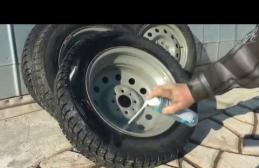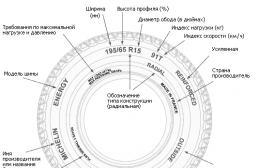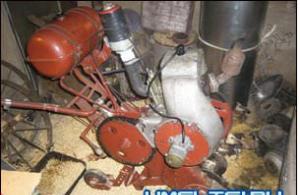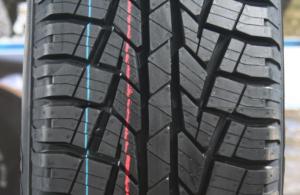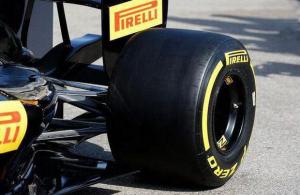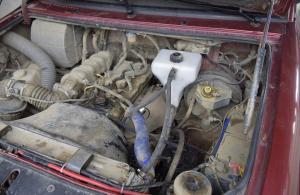 To ensure the safety environment on the territory Russian Federation special standards were developed and put into effect, which must be met by auto and motorcycle equipment supplied to the country. This piece of legislation is called the Technical Regulation "On Requirements for Emissions automotive engineering released into circulation on the territory of the Russian Federation, harmful (polluting) substances. " Euro 4 or 5 certificate for the car.
To ensure the safety environment on the territory Russian Federation special standards were developed and put into effect, which must be met by auto and motorcycle equipment supplied to the country. This piece of legislation is called the Technical Regulation "On Requirements for Emissions automotive engineering released into circulation on the territory of the Russian Federation, harmful (polluting) substances. " Euro 4 or 5 certificate for the car.
The Technical Regulations indicate the environmental classes of cars, which divide cars into classes depending on the volume of emissions. harmful substances in atmosphere. These standards are also called " Euro standards", they are made to control the content of toxic substances in the car exhaust. Environmental standards Euros were developed by the UN European Commission. Euro certificate for cars confirms that the car is environmentally friendly and causes minimal harm to the environment.
On the this moment there are several ecological classes of cars (EURO 2 (introduced in 2006), EURO 3 (2008), EURO 4 (2010), EURO 5 (planned to be commissioned in 2014)). Each standard is much stricter than the previous one; these standards in Russia are being introduced a little later than in the European Union. However, all equipment produced at the enterprises of the Russian Federation must meet the highest environmental standards, however, for equipment imported into Russia Euro certificate per vehicle may be required.
What is the certificate of conformity Euro 4 and 5 for?
As mentioned above, the technical regulation system monitors the environmental friendliness of cars, moto and special equipment that are used in the Russian Federation. These measures are primarily intended to preserve the environment and ecology of our country. The legislation establishes that the equipment imported into the territory of the Russian Federation since 2010 must comply with the Euro 4 standard. To confirm the ecological class, it may be necessary to issue a Euro certificate of conformity for a car of the established form.
Thus, confirmation of compliance of auto and motorcycle equipment with environmental classes may be required for submission to customs authorities during customs clearance, as well as for obtaining a vehicle passport. The lack of a Euro 4 or 5 certificate may be justified and legitimate reason refusal of the FCS employee in issuance of PTS on a car, and, therefore, a car without a Title Deed cannot be registered with the traffic police. It is also worth noting that the presence of Euro 5 certificates at the moment gives additional benefits in duties when registering trucks.
Registration of the Euro 4 and 5 certificate
The certificate of conformity of the car to the environmental class can be issued for both legal and individual... The standards by which the tests are carried out to check the conformity of the equipment are contained in the Technical Regulations "On the requirements for emissions of harmful (polluting) substances by automobile equipment put into circulation on the territory of the Russian Federation". A Euro 4 certificate of conformity for a car is issued by accredited certification centers, based on a laboratory test report.
Depending on the country and year of manufacture, the car usually meets certain environmental standards. Below is an average table showing the correspondence of countries and years of production and euro classes.
Attention: the table does not give a 100% guarantee of compliance, check with our managers.
| Country of origin of the vehicle | Years of release Vehicle, inclusive: | |||
| Not meeting the requirements of technical regulations at the time of import into the Russian Federation (having an environmental class 1 and below) | Compliant with the requirements of technical regulations, according to ecological classes | |||
| euro 2 | euro 3 | euro 4 | ||
| European Union, gasoline engines | Before 1996 | 1997-2000 | 2001-2004 | Since 2005 |
| European Union, diesel engines | Before 1996 | 1997-2001 | 2002-2004 | Since 2005 |
| Before 1995 | 1996-2000 | 2001-2003 | Since 2004 | |
| Before 1997 | 1998-2004 | 2005-2010Since 2011 | ||
| Canada | Before 2000 | 2001-2003 | Since 2004 | - |
| India | Before 2004 | 2005-2009 | Since 2010 | - |
| Malaysia | Before 2002Since 2003 | -- | ||
| China | Before 2003 | 2004-2007 from 2008- | ||
| Korea | Before 2000 | 2001-2002 | 2003-2005 | |
| Ukraine, category M | Before 2005 | Since 2006 | - | - |
| Ukraine, category N | Before 2006 | Since 2007 | - | - |
The form of the Euro certificate of conformity for the car has the established sample (it is similar to the form of the TR certificate of conformity). The form contains the following main fields:
- certificate number;
- validity period of the certificate;
- name of the certification body;
- meets the requirements normative documents;
- applicant;
- manufacturer;
- test report.
Terms and cost of the Euro 4 and 5 certificate of conformity
The cost of issuing a EURO certificate for a car depends on the type of vehicle, the date of production, the country of import, and you should also know the volume of the engine. After reporting this information, as well as providing the necessary documents, we will be able to report the final cost of the certificate. The period for issuing a certificate is usually 1-2 business days. If the EURO-4 environmental standard does not apply in the country that manufactured the car at the time of release, then this car does not meet the required ecological class, which means that in order to issue the Certificate, the machine must be re-equipped, installed optional equipment and, provide a document from the car service certifying these changes.
Delivery of EURO 4 certificate in Russia
We value the time of our customers, therefore, for all customers who have ordered a EURO certificate of conformity for a car, we can offer delivery of documents by leading courier and postal services in the Russian Federation and neighboring countries. Delivery is paid separately, the time and cost depend on the rates of the delivery service.
In 2017, a zone with a ban on the passage of cars with engines of an environmental class lower than Euro-4 should appear on the territory of Moscow. Preparatory work conducted by the Moscow government and the Ministry of Transport, the latter presented an ecological sign the day before, which will become the justification for the ban on travel. Experts are convinced that this innovation is contrary to the Constitution of the Russian Federation.
We are very soon waiting for the introduction of ecological zones in Moscow, where, after the trucks, passenger cars with engines lower than Euro-4 will be prohibited from passing. The law should be drafted soon, and in 2017 there will be restrictions on entry to some parts of the city. They talked about the borders of the Third Transport Ring (TTK), - a source told Life, citing a backstage conversation with a high-ranking official of the Ministry of Transport.
The Ministry of Transport indirectly confirmed this information, without announcing any terms and territorial ties.
Environmental signs will give city and municipal authorities preferences to restrict traffic in various zones of the city for vehicles below a certain environmental class, which will lead to an improvement in the environmental situation in cities, the press service of the Ministry of Transport told Life.
The Moscow Department of Transport did not promptly respond to Life's request. On November 30, Deputy Minister of Transport of Russia Nikolai Asaul presented new environmental signs at the international congress "Traffic in the Russian Federation" road traffic... Asaul said that the draft resolutions that will amend the traffic rules and all approval procedures have already been submitted to the government for consideration. It is noteworthy that on the presented signs only the ecological class "Euro-4" appears, not lower.
Life's interlocutor explained that no complex schemes need to be invented to implement the ban. In fact, the entire infrastructure for this is functioning now, weeding out freight transport. Road cameras The traffic police and the Center for Traffic Management (TsODD) will record non-environmentally friendly cars. The camera recognizes the license plate of the car in the restricted area, and in the traffic police database there is information about the environmental class of the car - in fact, each car model has a vehicle type approval, where everything is spelled out. If the class is lower, the owner of the car will receive a fine. Trucks are now fined 5 thousand rubles. Moreover, the sanction may be repeated several times along the route of the car.
The initiative to ban the entry of non-environmentally friendly vehicles into Moscow appears for the second time. In 2011, this measure was put forward as a tool in the fight for the ecology of the city. Then the initiator was the head of the Department of Nature Management and Environmental Protection of Moscow Anton Kulbachevsky. He also proposed to prohibit the entry into the city center of cars with an eco-class lower than Euro-4. However, things did not go further than loud statements that caused a harsh reaction from the townspeople. Kulbachevsky's department also did not respond to the actual request from Life.

According to the statistics of the analytical agency "Autostat", 42% of the capital's car fleet in terms of ecological class does not exceed the level of "Euro-3" and below, in the Moscow region - 49.5%, in Russia as a whole - 63.6%. Considering that about 800 thousand passenger cars come to Moscow every day (data Gosadmtekhnadzor of the Moscow Region), it turns out that 396 thousand people will no longer be able to do this since 2017.
The technology of screening out regional drivers is understandable, but the question remains unclear how Moscow officials will force the townspeople to abandon cars that do not meet the Euro-4 eco-class. The solution, again, can be borrowed from the current practice of the passage of trucks into the city: for example, for a medium-tonnage truck of the "gazelle" type, an annual travel ticket costs 28 thousand rubles. Numerous offices help to draw up this document in the City Department of Transport.
Such restrictions violate the constitutional rights of citizens, lawyer Leonid Olshansky is convinced.
This initiative violates at least two articles of the Constitution of the Russian Federation: 27th (freedom of movement) and 19th (all are equal before the law, regardless of social and material status). It turns out like this: one citizen has money for a new environmentally friendly car, and he drives it around the city without restrictions, and another citizen with the same rights to old car cannot go where he needs to. It turns out that people with disabilities, doctors, teachers and other vulnerable groups of the population must travel to public transport? - says Olshansky.

The leader of the "Motorists of Russia" movement Viktor Travin has a similar opinion.
In my opinion, this is a completely illegal measure. If the car has received numbers and is approved for use, it can go everywhere. You can close some nature protection zones for cars, but not the streets of the city! Separating cars according to the principle "this is possible, but this is not" - this is complete madness. It would be more honest to prohibit non-environmentally friendly cars altogether. In another way, you need to stimulate: reduce transport tax for environmentally friendly cars, for example, - Travin is indignant.
According to the leader of Avtomobilistov Rossii, the ban on entry is not aimed at the environment at all, but at increasing the number of fines.
The ban on movement in the central part of the city on "non-ecological" cars has been ripening at the top for a long time - the first proposals were announced 5 years ago. The idea naturally caused a storm of indignation among motorists, especially since the Euro-3 norm was then in use in Russia, and passenger buses and minibuses releasing a smoke screen behind them are commonplace. And now, towards the final of 2016, when the number of legislative initiatives in the field of toughening the rules for operating vehicles has already gone off scale, and the cost of monthly car ownership is approaching the average wages, the city authorities took a "dessert" out of the cupboard.
It is very likely that in the spring of 2017, entry into the TTK will be prohibited for those with an environmental class of a car below Euro-4. There is no need to doubt that in this case the bill will not fall under the rug - this is just another wonderful way"Filling the local budget" at the expense of inattentive drivers. In addition, three days ago, Deputy Transport Minister Nikolai Asaul officially presented new signs restricting the movement of vehicles depending on the eco-class. And here's what is strange: there is also a "four" on the sign for canceling the ban. The suspicion involuntarily creeps in that classes below the 4th may soon be banned altogether, especially since not so long ago the idea of disposing of all "non-ecological" vehicles flashed through.
Vice-President of the National Automobile Union Anton Shaparin noted that there is not enough information on the signs: “It must be indicated that cars with LPG can move freely anywhere. This is the most environmentally friendly transport. "
As for the implementation of the idea, then, according to officials, no problems are foreseen at all. All the necessary drafts of changes in traffic rules and other papers have already been submitted for approval to the government, the control and "penetration" structure has long existed, presenting fines to trucks that have thrust into the TTK, and it is not a problem to reconfigure cameras at all. Moreover, a citizen will receive as many fines as there are cameras on the way.
Now let's figure out who will be banned from going to the center. In the USA, they switched to the Euro-4 standard in 2004. In Europe - in 2005 (applies to both gasoline and diesel engines), in Korea - in 2006, in Russia - in 2010, in Japan - in 2011 and in China - in 2012. And from this it follows that mainly owners of used "Japanese women", "Chinese" and " our brands ”, of which there are a lot outside the Moscow Ring Road. But this is on paper, but in life everything is different. If suddenly there is no class mark in the MTS, it is better to punch your engine through the base in advance. There are many sites on the Internet that provide such a service. In a special form you need to enter 9 or all 17 characters of the VIN-code and wait for a response from the system. If everything is bad, there you can find absolutely legal and official proposals for converting a car to increase the ecological class with the subsequent re-registration, unless you have a carburetor. We called one of these companies that offer turnkey services with the conversion of cars to Euro-4 and changes to the PTS - the issue price fluctuates at around 90-100 thousand rubles. True, auto expert Andrey Leontyev doubts their omnipotence: “Yes, there are many such offices, the question is what they can do. To turn Euro-3 into Euro-4 - probably yes. But not on all engines, but, mainly, on those that the automaker itself has over time upgraded. Nobody will be able to raise Euro-0 to Euro-6. In addition, is it advisable to invest half the price in the legalization of your car worth 200-300 thousand rubles for trips to the center? "
Euro 4 certificate represents environmental standards that provide for restrictions on the content of harmful substances in exhaust gases cars. The Euro 4 standard was adopted by the European Union in 2005 and replaced the Euro 3 standard. new standard started in 2006. The Euro 4 vehicle exhaust requirements were revised and should not exceed the permissible limits:
CO - 4 g / kWh,
СН - 0.55 g / kWh,
NO - 2 g / kWh.
The Euro 4 standard applies to all imported and manufactured vehicles in the territory of the European Union. Those owners who have a Euro 3 certificate in their hands should re-equip the car in order to obtain a Euro 4 certificate. The validity of the issued certificate should not exceed four years.
In Russia, the Euro 4 certificate came into force on 01.01.2010. This is indicated in the Technical Regulations on Hazardous Automotive Emissions, which was adopted by the government on October 12, 2005 and was registered under No. 609. It began to operate 6 months after its official publication on November 21, 2005, that is, from May 20, 2006. From now on, this certificate applies to all imported and domestic cars, as well as engines. internal combustion... If you buy a car in a car dealership, then you do not need to issue additional certificates for it, since it must already comply with the environmental class of Euro 4 vehicles.
The Euro 4 certificate can be issued in a certification body accredited by RostekhUpravlenie by providing Required documents... First of all it's all technical documents for a car, an application for a certificate and a passport of the applicant, the owner of the car. It is worth noting that if the year of manufacture of the car is earlier than 1997, you should additionally provide the certification body with a certificate of re-equipment of the car in accordance with the law until the established environmental class of Euro 4. In such cases, a catalyst must be installed on the car to reduce emissions of harmful substances and a document on modernization in the service center.
To issue a Euro 4 certificate for legal entity, the certified center must additionally provide the Certificate of State Registration of the company and the Certificate of registration with the tax authorities TIN. You also need to provide a copy of a certificate stating that the car was registered with the tax office.
According to the legislation, the Euro 4 certificate must contain the following information:
- car model;
- year of issue;
- full name of the car;
- type of internal combustion engine, its volume;
- engine identification number.
When crossing the border of the Russian Federation and entering the customs territory, it is necessary to provide a Euro 4 certificate for those vehicles that may have a controversial issue in determining the environmental class. You can check, as well as determine, the ecological class of the car according to the database of the Ministry of Industry and Energy. This database contains all the information about cars that are produced in most countries of the world. Customs officers can determine the ecological class of a car, referring to its brand and data in the database of the Ministry of Industry and Energy. If the class of the car is not determined according to the base and the environmental certificate Euro 4 is not issued, then it is impossible to issue a PTS (vehicle passport), which is a prerequisite for the exit of a car or other vehicle on the roads of the Russian Federation.
Now on the territory of Russia there is a Euro 4 certificate, which confirms the ecological class of the car and allowable norms emission of harmful substances in car exhaust. If we compare the new Euro standard with the previous one, then the level of emissions of harmful substances has decreased by 70%.
The Russian government plans to adopt a new Euro 5 standard, which will replace Euro 4 and establish even more stringent conditions for the content of harmful substances in car exhaust, by 2014. It is worth noting that in Europe it has already been in effect since September 2009 for passenger cars.
According to Technical regulations, gasoline and diesel fuel, which complies with the Euro 4 standard, will be produced until 12/31/2013. Then the government plans to replace this standard with Euro 5. So far, there are no restrictions on the production of gasoline only according to the Euro 5 standard.
The Euro 4 and Euro 5 certificates of conformity have been developed to control toxic substances in vehicle exhaust. These standards were proposed by the UN European Commission with the aim of positive changes in the environment. Certification in accordance with Euro 4 and 5 standards guarantees that the car meets the norms and requirements of the environmental standard and does not harm the environment. The Euro 4 standard came into force in 2005 for the countries of the European Union. This standard assumes the release of less harmful substances into the environment than under the Euro 3. In the European Union, since 2009, more stringent Euro 5 requirements have been applied to diesel trucks. But what about Russia? The question arises: from what year does the Euro 4 class begin to operate? The Euro 4 certificate began to be issued in Russia from January 1, 2010 in connection with the increased requirements for the environmental class of cars used in the territory of the Russian Federation.
We will issue Euro 4 and Euro 5 certificates from 5000 rubles
The processing time is from 1 day.
We carry out re-equipment for Euro 4 and Euro 5 with the registration of an act of re-equipment and a test report for a single vehicle. Experienced experts will help in the preparation of documents for a car for submission to customs and other government bodies... After the introduction of new requirements for the ecological class of cars in Russia, they began to maintain the Euro 4 standard. All cars, as well as car engines imported into the territory of our country must comply with Euro 4 classes, and since 2013 - Euro 5. It was planned that after the introduction of such stringent standards, cars produced by factories in the Russian Federation would become safer for the environment. A list of vehicles that are produced in accordance with the new standard for export abroad was compiled. Euro 4 cars are much less harmful to the country's ecology, improving the indicators of the content of harmful toxic substances in the air. Which cars are Euro 4 compliant? By law, all cars after 2010 must be equipped for Euro 4. However, in reality this is not so easy. Not all cars in Russia can quickly change their characteristics under Euro 4. For example, VAZ cars do not meet the specified standards. All cars manufactured at the factories VAZ, Kamaz, Gaz, Maz on the territory of the Russian Federation, according to the results of tests carried out by the level harmful emissions are approaching the requirements of Euro 4, but they are still far from Euro 5. An interesting fact is that some models of Maz and Maz-Man cars are produced in the Republic of Belarus that meet the requirements of the Euro4 standard and, as the manufacturers assure from the beginning of 2013, their engines will show Euro 5. In this regard, domestic cars(Vaz, Gaz, Kamaz) a delay was given for a couple of years so that the owners could spend necessary actions to re-equip their vehicles. You can make Euro 4 at the manufacturing plant or at a certification center that has the appropriate equipment to carry out the necessary work.
In order to independently determine whether your car meets the requirements of Euro 4 and Euro 5 standards, you can use the Eurostandard table. However, this is not always possible. It is easier to contact experts by phone and, with their help, find out whether your car complies with European environmental standards. A Euro 4 certificate in Russia is issued only after proper conversion work has been carried out for Euro 4 and Euro 5. Today, you need to buy Euro 4, there is no other way. To do this, you must submit the vehicle and documents to a certified center or conversion center. These are documents for the car (PTS), the owner's identity card and, of course, the application for refurbishment. To get Euro 4, the price depends on the age of the car and on the amount of work that needs to be done for the conversion. Trucks have even more serious requirements than passenger cars... After the entry into force of the Euro 4 standard Russian plant KAMAZ presented a novelty: engines that comply with Euro 4 and samples of trucks that comply with the European environmental class. But these are new items, and what to do if the car was made earlier. In this case, you need to make a conversion for Euro 4. Euro 4 and Euro 5 for KAMAZ and MAZ can be obtained in our certification center after the conversion. But here's another caveat. The fact is that the class of a car can only be raised by one unit. For example, if the standard was Euro 3, then you can make Euro 4, and if the class corresponded to Euro 2, then Euro 4 cannot be made from such a car. The cost of Euro 4 in Moscow fluctuates depending on the complexity of the work and the condition of the car.
The Euro 5 certificate is an indicator of the environmental class of the vehicle. In the European Union, this standard was introduced back in 2008. True, only trucks... However, in the second half of 2009, the Euro 5 standard extended to cars same way. Euro 5 cars are less harmful to the environment, as they have reduced emissions of harmful substances. Thanks to improved engines, Euro 5 cars emit significantly less carbon monoxide into the atmosphere. In order to convert a car from Euro 4 to Euro 5 in Europe, it is enough to contact a special commission, whose consultant will suggest a more convenient modernization for specific car... In the Russian Federation, the transition to the Euro 5 standard is planned for 2013-2014. However, there is an intensive preparation for the introduction of new requirements for the ecological class of vehicles. Euro 5 standards in Russia will become relevant in 2 years, the process of obtaining a Euro 5 certificate will not differ in any way from obtaining Euro 4. At present, legislative regulations for obtaining Euro 5 have not yet been developed. Domestic manufacturers have already begun production of cars equipped for Euro 5. Since 2010, AVTOVAZ has been producing export cars that meet European standards... It should be mentioned here that the toxicity standards in Euro 5, in contrast to Euro 4, will be checked after a run of 160 thousand km. The new requirements will also make it necessary to revise the production of cars in Russia. Developers domestic cars should improve factory equipment... To make it possible to produce a car with Euro 5. The Lukoil fuel company is already supplying diesel fuel to foreign and domestic markets that meets the requirements of the Euro 5. Such fuel can make the car run quieter, and raise the wear resistance indicators by new heights, reducing the release of combustion products into the atmosphere.

